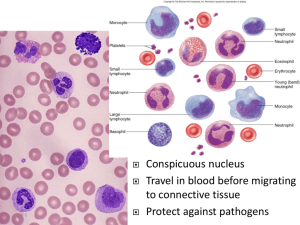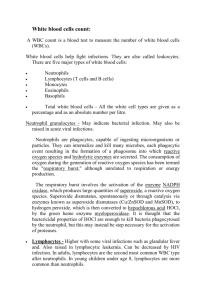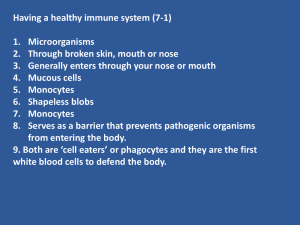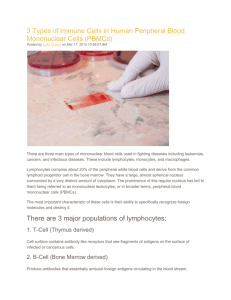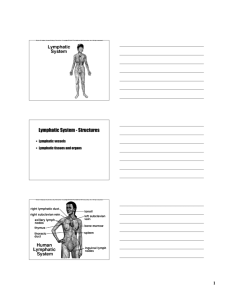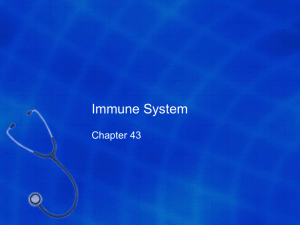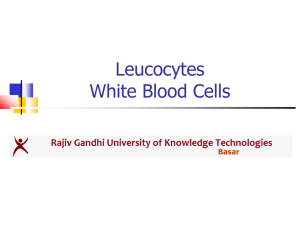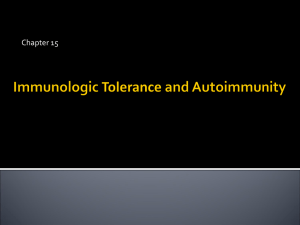Immune Response
advertisement
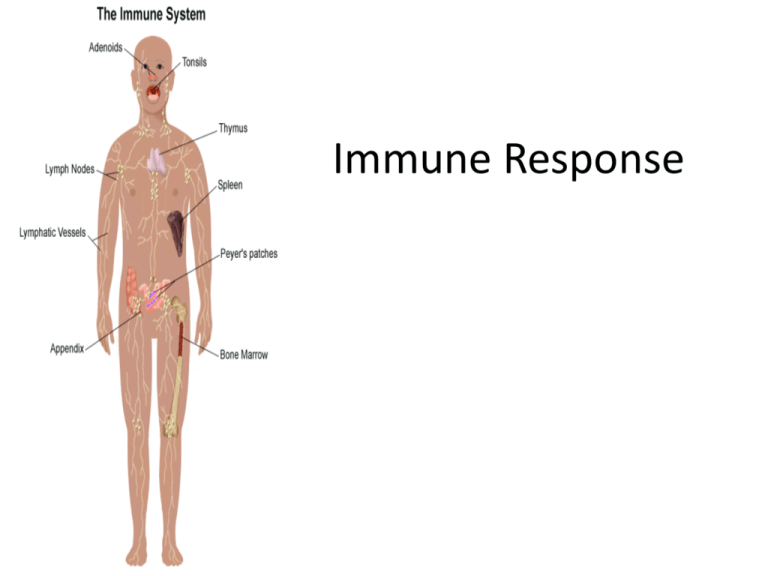
Immune Response Vocabulary • Immunology- the study of host defense mechanisms • Immunity- ability of the host to protect itself against foreign organisms. Resistance to disease. • Antigen (Ag)- is a foreign substance that can elicit specific immune response (IR) when is immunogenic • Antibody (Ab)- protein produced by the body’s immune system when it detects harmful substances called antigens • White blood cells (leukocytes)- chief function is to protect the body against microorganisms causing disease and fight infection when it occurs. They are bigger than red blood cells. 2 Leukocytes (White Blood Cells (WBC)) • Protect the body against microorganisms, toxins, & tumor cells. • • • remove dead cells & debris from body Complete cells with all organelles Stained & further identified by • • • • size shape of the nucleus presence/absence of granules colors taken up by their granules 3 • Normal Blood Smear – WBCs account for less than 1% of blood’s volume 4 White Blood Cells (WBC) • 5 Major types of WBC – Neutrophils – Eosonophils – Basophils – Lymphocytes (T and B Cells) – Monocytes • Divided into two categories – Granuolocytes and Agranuolocytes 5 Granuolocytes • Neutrophils – are the most common WBC in peripheral blood. – Circulate in blood 7-10 hrs before migrating into tissue • Live only a few days (1-2 in tissue) – “front line of innate defense” • 1st WBCs to show up at an infection site – – – – Increase in # used as an indicator of infection Extravasate in inflammation rxn Active phagocytes Fungi 6 Granuolocytes • Eosinophils – Defend the body in parasitic infections • Tapeworms, hookworms, pinworms – Function in phagocytosis – Account for less than 5% of WBC – Involved in allergies • Reduce or control inflammatory response by destroying histamine – Red bi-lobed nucleus with red granules 7 Granuolocytes • Basophils – Least common WBC in blood – Non phagocytic – Smallest but loudest • Function as “sirens” for inflammation and allergy – Produce histamine (a vasodilator) and heparin (blood thinner) – Large, histamine containing granules that stain dark purple to blue 8 Agranulocytes • These WBC’s lack visible cytoplasmic granules • Lymphocytes • Monocytes 9 Agranuolocytes • Lymphocytes – Cornerstone of the immune system • 2nd most abundant cells – Smallest of the WBCs – Help provide a specific response to attack the invading organisms – Are formed in lymphatic tissue throughout the body • Migrate to lymphatic organs to proliferate – Two types of lymphocytes • T cells and B cells, which differ in function and the molecules that are on their surface also differs 10 11 Agranuolocytes • Lymphocytes – T cells • Circulate through the thymus gland and turn into cells known as thymocytes – More than 80% of lymphocytes circulating in the body are T cells • When exposed to antigens, they rapidly divide and produce large number of new T cells that are sensitive to that type of antigen – Destroy viral infected cells, as well as cancerous cells 12 Agranuolocytes • T cells Cytotoxic cells (Tc) 3 main Helpergroups T cells – Divided into Suppressor T cells Sometimes called “Killer Cells” Assist “killer cells” in performing their activities Moderate the immune response by inhibiting cytotoxic cells and B cells They produce chemical substances that are essential in helping the B cells destroy foreign substances Help protect the body against disease by increasing response of other immune cells Prevent autoimmunity- control overproduction of both T and B cells Physically attack foreign cells- infected and cancerous cells Stimulate production of T and B cells 13 Agranuolocytes • Lymphocytes – B cells • Circulate in the blood in an immature way • About 10% that circulate the blood are B cells • Produce proteins known as antibodies – Antibodies attach to foreign pathogens in the body known as antigens that are found on the surface of certain microorganisms – When B cells divide they produce an identical copies of antibodies on their surface 14 Agranuolocytes • Monocytes – Largest WBC found in the blood – Play important role in the inflammatory response – Leave the blood stream (after 2-3 days) to become macrophages • As a monocyte or macrophage, these cells are phagocytic (engulfing) and defend the body against viruses and bacteria • Present pieces of pathogens to T cells so that pathogens may be recognized and killed – Increase in chronic infections 15 Macrophages • Arise from monocytes in bone marrow • Engulf foreign matter and present antigens on surfaces where they are recognized by immunocompetent T cells - macrophages then termed antigen presenting cells or APCs • Also secrete soluble proteins that activate T cells which in turn release chemicals to activate more macrophages. Dendritic Cells • Are a system of antigen presenting cells that function to initiate several immune responses such as the rejection of organ transplants, and the formation of T-dependent antibodies • Found in many non-lymphoid tissues but can migrate via the afferent lymph or the blood stream to the T-dependent areas of lymphoid organs where in the periphery capture and process antigens, express lymphocyte co-stimulatory molecules, and secrete cytokines to initiate immune responses • Tolerize T cells to antigens that are innate to the body (self-antigens), thereby minimizing autoimmune reactions • Dendritic cells are present in those tissues that are in contact with the external environment, such as the skin, and the inner lining of the nose, lungs, stomach and intestines
